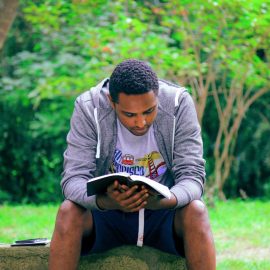

This article gives you a glimpse of what you can learn with Shortform. Shortform has the world’s best guides to 1000+ nonfiction books, plus other resources to help you accelerate your learning.
Want to learn faster and get smarter? Sign up for a free trial here .
Would you like to know God and the Bible better? Do you wonder how to start reading the Bible and make it a habit?
Personal Bible study is the most powerful catalyst for spiritual growth, yet many Christians don’t know how to start reading the Bible. We’ve put together some Bible reading tips and Bible resources to help you in your journey.
Keep reading to learn how to start reading the Bible in a way that helps you stick with it long-term.
What the Bible Is
The Bible is unlike any other book. So, before we directly address how to start reading the Bible, it’s helpful to discuss exactly what it is.
The Bible is the message (word) of God and the story of God. It’s the primary way that God communicates with us, and it’s the best way to get to know Him. The Bible’s authors are people; God gave them His inspired thoughts, and they wrote them in their own words.
The central purpose of the Bible is to help us know God; it’s a relationship tool. This results in our personal transformation, as it restores the loving character of God in us. The Bible has several secondary purposes, as well, including these:
- Teaching—The Bible is chock full of stories and wise counsel that teach us how to live. It can be considered a user’s manual for life.
- Encouragement—Throughout the Bible, we’re reminded that God loves us, He created us for a good purpose, and He is always with us.
- Hope—The Bible contains promises and prophecies that tell us that each one of us can choose resurrection and eternal life, a life in the New Earth, where “there will be no more death or sorrow or crying or pain. All these things are gone forever.”
- Perspective—The Bible presents a sweeping picture of time and space, reminding us that there’s so much more—and so much better—than our current circumstances.
The Bible’s Structure
If you want to learn how to start reading the Bible, familiarize yourself with how it’s structured. The Bible is really a collection of books—66 books written by over 40 authors over a period of 1,600 years in over a dozen countries on three different continents in at least three different languages by people from all walks of life. Still, it has a unified theme: God is love, and He loves us.
The Bible is divided into two major parts: the Old Testament and the New Testament. When Jesus was on earth, in the first century AD, the only scriptures were what we now call the Old Testament. At that time, they often were referred to as the Law and the Prophets. The New Testament was written in the first century AD, and it includes the Gospels (the books of Matthew, Mark, Luke, and John), which tell the story of Jesus on Earth.
Bible Translations and Paraphrases
Since you’re inquiring about how to start reading the Bible, you’re probably curious about what kind of Bible to use. The Bible has been translated many times, so many versions are available. The New International Version (NIV) is perhaps the most popular version, the Modern English Version (MEV) might be the most accurate translation, and the New Living Translation (NLT) is one of the most readable.
Bible paraphrases also are available. Examples include The Message and The Living Bible. These are not direct translations. Because of that, they’re not as true to the original, but they are highly readable and offer some interesting nuances.
When it comes to casual reading, paraphrases are great. When it comes to Bible study, it’s a good idea to use a combination of direct translations to get the most accurate understanding.
Bible Formats
You can use a printed Bible or a digital Bible on the web or with an app. Each format has its advantages.
- Print—A printed Bible helps you see where books and passages are in relation to each other, which is quite valuable.
- Digital—It’s super easy to have the Bible with you all the time. Finding passages can be quicker and easier. You also have the option to listen to the Bible—and even watch some of the Bible (more on this later).
How to Find Bible Passages
As you learn how to start reading the Bible, another “prerequisite” is figuring out how to find Bible passages. The way to find texts in digital editions varies by app, so we’ll discuss a printed Bible here.
John 3:16 is probably the best-known Bible verse. John is one book in the Bible. As with most books, it’s divided into chapters. Each chapter is divided into verses (usually a sentence or two). Think of it this way: Book > Chapter > Verse. “John 3:16” refers to the book of John, the third chapter, the sixteenth verse.
How can you find John 3:16? Most Bibles include a table of contents near the front that indicates what page each book starts on. Go there to find the page on which the book of John starts. Once you are in John, find chapter 3. Once you are in John 3, find verse 16.
Bible Reading Tips
Once you know what the Bible is, how it’s structured, and how to access it, it’s much easier to get started. Here are some tips on how to start reading the Bible and stick with it.
How to Start Reading the Bible
The Bible is unique, so it’s not exactly like reading any other book. While it’s generally chronological, starting on page one and continuing through to the end is not necessarily how to start reading the Bible for the first time. A good way to get started is by praying (if you’re comfortable), getting in the right mindset, and heading straight for the Gospels.
Pray
If you’re comfortable doing so, pray before you read. Remember that prayer is just talking to God. Sample prayer: Dear God, please help me understand what You’re saying to me—to see You in the stories and to know You better.
It’s also a good idea to pray after you read. Sample prayer: Dear God, please help me take what I’ve read to heart and apply it to my life in a practical way that makes a difference. Thank you for spending this time with me.
When you keep in mind that the Bible is God’s primary way of talking to you, it’s easier to “talk back” in prayer—before, during, and after you read. It might not be comfortable for you yet. But, the more you do it, the more comfortable it will feel—and you’ll find that you have more to say.
Have the Right Mindset
As you learn how to start reading the Bible, don’t overlook the importance of mindset. As with any reading experience, it’s wise to go into it with a healthy attitude and frame of mind. Let’s look at three aspects of the right mindset for reading the Bible.
Manage Your Expectations
If you expect to get hooked right away, understand everything completely, and have an overnight life-changing experience, you’ll be disappointed. Sure, God sometimes works by miracles, but He usually works by principles. Don’t expect miracles, but do expect—over time—to learn new things, to be encouraged, to find hope, to know God better, and to become more and more like Him.
Be Open
With your Bible reading experience, stay as objective as possible. Keep your mind open to new thoughts and new ways of thinking. Lay aside preconceived notions and what you think it says or what you want it to say. Don’t read into it; get the meaning out of it.
In The Purpose Driven Life, Rick Warren urges Bible readers to be receptive. Listen to God’s Word with an open mind, looking for the lessons. If you think you aren’t learning anything, examine your mindset. There is always something to learn from the Bible. So, if you’re not learning, it’s because you have a closed-off attitude. Focus your mind on being open to new ideas and lessons.
Don’t Get Discouraged
Let’s face it—the Bible is huge. It’s profound. It’s, well, daunting. Scholars spend their whole lives wrestling with scripture. You’re not going to understand it all completely, so don’t get discouraged when something doesn’t make sense to you.
The more you read, the more you’ll understand. The Bible has an amazing way of explaining itself, which is why it’s important to read all of it—eventually. You’re just getting started, so be patient. Give it time.
Be encouraged just by the thought that you’re reading the Bible. Be encouraged when you get anything out of it at all. Don’t compare yourself with others; compare yourself to who you were last year. You’re already ahead.
Start With the Gospels
In learning how to start reading the Bible, where you start is a major factor. While there’s certainly value in reading the Bible from beginning to end—Genesis to Revelation—that’s not necessarily how to start reading the Bible for the first time.
In the first chapter of the Gospel of John, John refers to Jesus as “The Word.” John says that Jesus became human and came into the world to show us what God is like. The Gospels—the New Testament books of Matthew, Mark, Luke, and John—tell the story of Jesus on Earth from four different perspectives.
The Gospels give us the best picture of what God is like and how He works. So, any of these books is a great place to start reading the Bible. Then, you can do a bit of time travel to other parts of the Bible with a good idea of what God is like.
How to Keep Reading the Bible
Once you’ve learned how to start reading the Bible, stay on track by making a plan, reading every day (making it a habit), and taking full advantage of what the experience offers.
Make a Plan
You should make a plan for what to read and when to read. Keep in mind that your Bible reading plan must be sustainable—something you can realistically stick to. For example, don’t plan to read for an hour every day or to read the whole Bible in a month.
What to Read
In his discussion of how to start reading the Bible, Rick Warren contends that a reading plan helps you read with purpose instead of jumping between sections or missing out on sections that might not seem interesting.
If you search “Bible reading plan” online, you’ll find a ton of ideas and resources. Bible apps typically include reading plans; some printed Bibles do, as well. You’ll find plans that take you through the Bible in a year, plans that cover topics such as marriage and end times, and plans that focus on particular books of the Bible.
If you start reading the Bible in the Gospels, as recommended above, you could make a simple plan to read one chapter of John every day. You might ask God for guidance on what plan to make. Whatever you choose, pick something that fits you right now.
When to Read
Part of learning how to start reading the Bible is finding a way to integrate it into your life. The short answer to the “when to read” question is “every day.” We’ll deal with the daily habit aspect of Bible reading in the next point. For now, it’s enough to make a plan for what part of the day you’ll read.
A great way to establish a new daily routine is to anchor it to another daily activity, such as morning coffee or bedtime. An audio Bible reading is easy to listen to during your daily commute or exercise. Choose something you already do every day, and anchor Bible reading to it.
You might also make a plan for where to read, which could help you enjoy the experience and make it a habit. Perhaps you could start your day in the window seat with a cup of tea and your Bible.
Read Every Day
When Jesus prayed, “Give us this day our daily bread,” He very well might have been talking about scripture. It’s clear from the Gospels that Jesus knew God’s Word very well. He recited passages from memory. He must have grown up reading it regularly.
In most parts of the world, it’s easier than ever to read the Bible. We literally have it at our fingertips. We should seize the opportunity and make Bible reading a daily habit.
It’s better to read one verse a day than to read a chapter once a week or a book of the Bible once a month. In fact, as you’re learning how to start reading the Bible, just one verse a day might be your plan, and that’s perfectly fine. The main point is regularity—habit.
Reading is one of the six habits of the Miracle Morning. The Miracle Morning is a structured six-point daily personal development time. Many practitioners spend their morning reading time with the Bible or another religious text. Author Hal Elrod explains in his book The Miracle Morning that reading can equip you with life-changing knowledge. There’s arguably more life-changing knowledge in the Bible than in any other book, so just think about the treasure you have at your disposal.
Make the Habit Stick
Forming a habit takes time, and barriers might arise that prevent you from succeeding. Try the following three techniques from The Success Principles to increase the likelihood that your new Bible reading habit will stick:
- Write your plan on slips of paper and post them around your home. Visually prompting yourself about your habit makes you more likely to remember and cement it in the long term.
- Work with a partner. Recruit someone who is also working on a new habit so that you encourage each other to continue. Share your progress at least once each week.
- Commit to 100 percent follow-through. Choose to follow through on your habit completely rather than leaving any wiggle room for other options. Full commitment means you stick to your plan at all times, including when you’re tempted to slide.
If you’d like more information and tips on habits, Atomic Habits and Tiny Habits have helped countless others.
All of that being said, when you miss a day (you will), don’t get discouraged. That day is already behind you. You still have today and tomorrow.
Take Full Advantage of the Bible
Due to persecution or poverty, not everyone in the world has the luxury of reading the Bible. If you have the opportunity, take full advantage of it. Soak it up. Squeeze every ounce of value out of it. Appreciate the treasure that it is. The more you enjoy reading the Bible—and the more you get something out of it—the easier it will be to keep going.
To take full advantage of the Bible, practice the following advice for finding valuable insights and applying what you read to your life.
Find Valuable Insights (Study)
As you read, consider what the passage says about God. Consider what it might mean for you. Write questions down. You might or might not seek answers to the questions, but even the practice of asking will give you a better understanding of what you are reading. (There’s a surprisingly effective Bible study method that involves only asking questions about a passage—as many as you can think of.)
Don’t merely let the Bible do the thinking for you. Let the concepts bounce around in your mind before they settle. James McCosh, a philosopher of the Scottish School of Common Sense and the president of Princeton University from 1868 to 1888, said this: “The book to read is not the one which thinks for you, but the one which makes you think. No book in the world equals the Bible for that.”
Consider the passage’s context, and don’t draw conclusions based on one text. To understand what the Bible teaches about a particular topic, take into account everything it says on the topic and see it in the context of the whole Bible. Again, that’s why reading the entire Bible is important, but allow time for that. For now, be content that some texts will make more sense as you read more of the Bible.
Recognize the difference between reading and studying. In The Purpose Driven Life, Rick Warren writes that Bible study should go hand-in-hand with your reading. Effective study involves reflecting on the information you’re reading and writing down your thoughts, questions, and insights. Your questions and insights don’t need to be especially profound or poetic—simply asking who, what, where, when, why, and how will make you more engaged with the text.
You might have heard of the concept of meditation in the context of Bible reading. Warren explains that meditating on God’s Word means choosing a verse, focusing on it, and thinking about it over and over again. This firmly plants the verse in your mind and lets you explore it and understand it from many different angles. Meditation doesn’t mean clearing your mind; it means filling it with something to ponder.
While The Miracle Morning isn’t specifically about Bible study, Elrod offers some tips on getting the most out of any reading material:
- Articulate why you’re reading a particular book, including what you want to gain. Then, keep that in mind as you read.
- Take notes and highlight useful passages to reinforce what you’re learning and to make it easy for you to review the most important information later. (The sixth Miracle Morning practice is scribing, which can go hand-in-hand with reading. Writing in a journal allows you to record insights, ideas, successes, lessons, and opportunities for development.)
- Re-read material. You can’t retain and apply everything of value after a single reading. You need repetition to embed the ideas in your subconscious.
Apply What You Read
Bible reading should be transformational. It should inspire life change. It should make you more and more like Jesus. That involves translating knowledge into attitudes and behaviors.
Warren writes that it’s incorrect to think that, once you’ve read something, you’ve absorbed the lessons and understood it. To truly understand the lessons of God’s Word, you need to apply them to your life.
Each time you read and study the Bible, think about the lesson in it. Then, create a plan to use the lesson in your life. A good action plan is specific and has three parts:
- It’s personal and involves one of your own relationships or character development.
- It’s doable.
- It has a deadline. For example, if you read the story of the Good Samaritan, you might make a plan to help someone you don’t know within the next week to develop your capacity for helping others without receiving anything in return.
Relate to God
Keep in mind that the Bible is the primary way that God communicates with us, and it’s the best way to get to know Him. The central purpose of the Bible is to help us know God; it’s a relationship tool. If you’re merely assimilating information and not personally relating to God, you’re doing it wrong—and you’re missing out.
When you read the Bible, realize that it’s God speaking to you. Respond by asking questions, saying thank you, or whatever is on your mind. Your daily routine of Bible reading is time spent with God. Nothing can take its place, and no one can take it away from you.
When you take full advantage of the Bible—finding valuable insights, applying it to your life to become more like Jesus, and relating to God in a personal way—you’ll be far more likely to stick to your Bible habit. You won’t want to give it up!
Bible Resources
You can find countless Bible resources online. We’ll include just a few here to give you an idea of what’s out there.
Bible Gateway
With Bible Gateway, you can read the Bible, find reading plans and devotionals, search for passages, keywords, and topics—and much more. They have a mobile app, as well.
For example, if you want to read Psalm 23, put “psalm 23” in their search box and then read it in a wide variety of versions. If you want to know where the Bible talks about the Holy Spirit, put “holy spirit” in the search box, and all of the textual and topical references will come up.
YouVersion
YouVersion has many of the same features as Bible Gateway. It’s one of the best mobile Bible apps around. With this Bible resource, you can highlight and take notes digitally and subscribe to the Verse of the Day. They also have a collection of videos and several resources for kids.
Blue Letter Bible
The first time the Bible mentions that Adam and Eve were naked, it meant that they weren’t wearing any clothes. The second time it says they were naked, it meant that they felt vulnerable—exposed in a psychological rather than a physical way.
If you read the Bible only in English, you probably won’t pick up on that distinction because the English word “naked” is used both times. However, if you use Blue Letter Bible, you can switch on Strong’s Concordance (Hebrew and Greek Lexicon) and see that the Hebrew words are different.
This Bible resource has several other features, as well, but what really sets it apart is its integration of Strong’s Concordance. If you want to get into the nitty gritty of Bible meaning and understand it on a deeper level, use Blue Letter Bible.
Daily Audio Bible
If you struggle to be consistent with daily Bible reading, this could be the answer. Daily Audio Bible is one of the best (if not the best) audio versions of the Bible available. It rises above the others because it’s the Bible read fresh every day. Each and every day, year after year, Brian Hardin reads the Bible, following a plan that takes you through the whole Bible in one year. Each reading includes passages from the Old Testament, New Testament, Psalms, and Proverbs. Most days, Hardin includes a bit of commentary.
Daily Audio Bible has options for different languages, teens, and kids. It also has a community element with its Prayer Wall.
The Visual Bible
Several viewable Bible dramatizations have been produced over the years. If you’re looking for a production that is word-for-word scripture, check out The Visual Bible Matthew and Acts. These New Testament books come to life in a new way, making the Bible even more accessible and compelling. Matthew, in particular, is a great place to start “reading” the Bible.
Check out these Bible resources, and add any you find helpful in the comments below.
Wrapping Up
The fact that you’ve read this article means that your Bible-reading journey has already begun. Now that you have a handle on how to start reading the Bible, keep in mind these main points to integrate scripture into your life as you continue on your journey:
- Remember that the Bible is a relationship tool meant to connect you to God personally.
- Find a daily rhythm that works for you.
- Take full advantage of what God’s Word can do in your life.
Get started, and keep going. It will be one of the best decisions you’ve ever made.

Want to fast-track your learning? With Shortform, you’ll gain insights you won't find anywhere else .
Here's what you’ll get when you sign up for Shortform :
- Complicated ideas explained in simple and concise ways
- Smart analysis that connects what you’re reading to other key concepts
- Writing with zero fluff because we know how important your time is







Very helpful! Thank you.